![]()
![]()
![]()
Use LEFT and RIGHT arrow keys to navigate between flashcards;
Use UP and DOWN arrow keys to flip the card;
H to show hint;
A reads text to speech;
4 Cards in this Set
- Front
- Back
- 3rd side (hint)
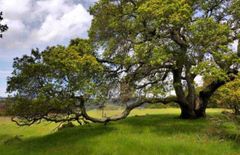
California native; Evergreen; short, stout trunk; crooked, spreading branches; leathery, oval, convex, holly like leaves; fruit is an hourly egg shaped, brown acorn; smooth gray bark becomes deeply thorough and thick with age |
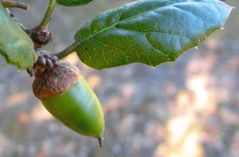
Quercus agrifolia (Coast Live Oak) OFTEN CONFUSED WITH INTERIOR LIVES OAKS (QUERCUS WISLIZENI) WHICH HAS FLAT LEAVES AND MAY HAVE FLAT OR TOOTHED MARGINS Full sun to partial sun; 10 to 20 feet tall and wide; old trees can reach 100 feet; prefers deep, well draining loam which it usually develops over time from leaf drop; prefer to have their roots shaded with either mulch, rocks or smaller native plants; susceptible to Gold spotted oak Borer and Sudden Oak death |

|
|

Deciduous; irregular, spreading and arching branches; during autumn leaves turn yellow to light orange but become brown during mid to late fall; older branches assume a drooping characteristic; pewter colored rippled bark; leaves or matte green with pale green on the bottom side; leaf is covered with fuzz; leaves release aromatic sent when rubbed or broken; can tolerate wildfires |
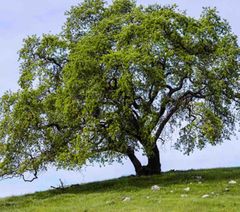
Quercus lobata (Valley Oak; California White Oak) 60 to 100 feet tall; 50 feet wide; largest of the north American oaks can tolerate wildfires, although smaller trees may be top killed; Low water; full sun; prefers deep, rich soil; deer resistant |
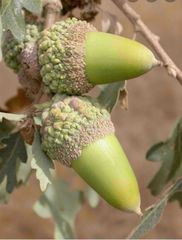
|
|
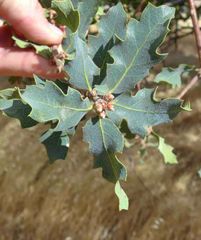
Deciduous; native to California; irregularly shaped crown; light gray bark with medium sized dark cracks; can appear almost white; the name derives from the dark blue green tint of the leaves;Very slow growing |
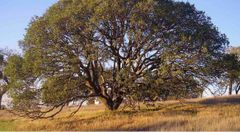
Quercus douglasii (Blue Oak) 16 to 80 feet tall; 30 feet wide; upright rounded or columnar form; no fragrance; full sun to part shade; long moisture; deer resistant; can be used for bank stabilization
|
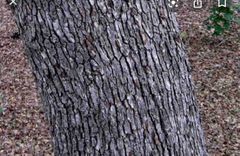
|
|

Rare oak native to Southern California; moderately fast growing; upright form when young but all the specimens often have a spectacular gnarled trunks and winding branches; Park is thick, furrowed, and light gray brown. Leathery blue green leaves which may be flat or wavy with smooth margins. |
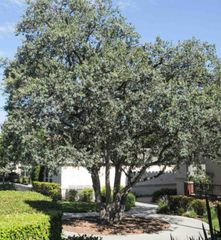
Quercus Engelmanii (Engelmann Oak) 32 to 65 feet tall; 90 feet wide; rounded form; semi deciduous; stay green year-round if near a damp or irrigated area, or where they can put their roots into groundwater; if drought stressed, they often go summer deciduous; full sun to part shade; low moisture; deer resistant; can be used for bank stabilization |
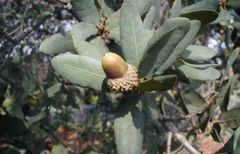
|

